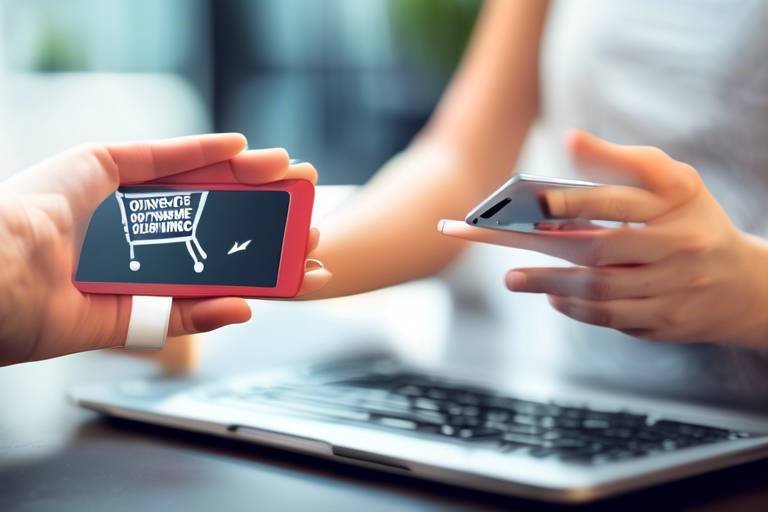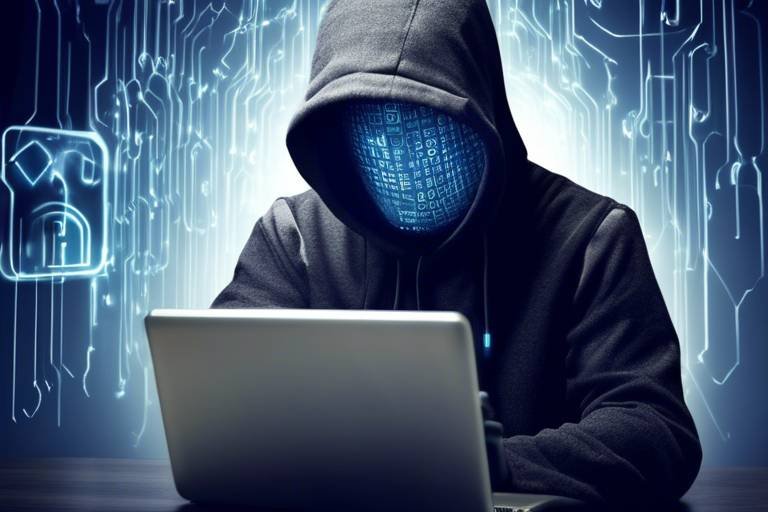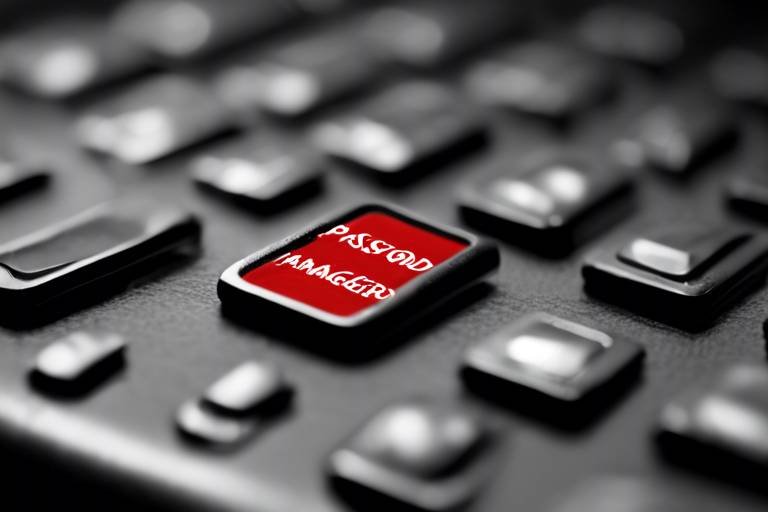How to Secure Your Personal Data on the Internet
In today's digital age, protecting your personal data is more important than ever. With the increasing amount of information we share online, it's crucial to understand how to safeguard your privacy and minimize the risks associated with our digital interactions. Whether it's your social media profiles, online banking, or even your shopping habits, every click can potentially expose you to threats. So, how can you effectively secure your personal data and ensure that your online presence remains safe? Let's dive into some essential strategies and tools that will help you navigate the complex world of online security.
Recognizing the types of personal data at risk is crucial for effective protection. Think of your personal data as a treasure chest; the more valuable the contents, the more attention it will attract from thieves. Common threats in the digital landscape include:
- Identity Theft: Criminals can use your personal information to impersonate you, leading to financial loss and damage to your credit.
- Phishing Attacks: These deceptive tactics trick you into providing sensitive information by masquerading as trustworthy entities.
- Malware: Malicious software can infiltrate your devices, stealing information and compromising your data security.
Understanding these threats is the first step in developing a robust defense strategy. Just like wearing a seatbelt while driving, being aware of these risks can help you stay safe in the unpredictable terrain of the internet.
A strong password is your first line of defense against unauthorized access. Think of it as the lock on your front door; if it's weak, intruders can easily gain access. To enhance your online security, consider the following best practices:
- Use a mix of uppercase and lowercase letters, numbers, and special characters.
- Avoid using easily guessable information, such as birthdays or names.
- Make your password at least 12 characters long for added security.
By implementing these practices, you can significantly reduce the risk of unauthorized access to your accounts.
Password managers can simplify the process of generating and storing complex passwords. Imagine having a personal vault that securely holds all your passwords, so you don't have to remember each one. These tools not only create strong passwords but also fill them in automatically when needed, saving you time and hassle. Some popular password managers include LastPass, Dashlane, and 1Password, each offering unique features tailored to different user needs.
Not all password managers are created equal. When selecting one, consider factors such as:
- Security Features: Look for end-to-end encryption and two-factor authentication options.
- User Interface: Choose a manager that is easy to use and navigate.
- Cross-Platform Compatibility: Ensure it works on all devices you use, from smartphones to laptops.
By choosing the right password manager, you can enhance your security and make managing your passwords a breeze.
Two-factor authentication (2FA) adds an extra layer of security to your accounts. It's like having a second lock on your door; even if someone manages to get past the first one, they still need the second key. Enabling 2FA is often as simple as linking your account to a mobile app, like Google Authenticator, or receiving a text message with a verification code. This extra step can significantly reduce the chances of unauthorized access, making it a crucial part of your online security strategy.
Phishing scams are a prevalent method for stealing personal information. They often come disguised as legitimate emails or messages, tricking you into clicking on malicious links. To avoid falling victim, always verify the sender's email address, look for spelling errors, and never provide sensitive information unless you're certain of the recipient's identity. Think of it as a digital con artist trying to pull a fast one on you; staying vigilant is your best defense.
Your home Wi-Fi network can be a gateway for cybercriminals if not properly secured. Imagine leaving your front door wide open; that's what an unsecured Wi-Fi network does. To protect your network, consider the following essential steps:
- Change Default Router Settings: Customize your router's settings to enhance security. This includes changing the default username and password, as these are often easily accessible to hackers.
- Use Strong Encryption: Enable WPA3 encryption for the best security, or at least WPA2 if WPA3 is unavailable.
- Regularly Update Firmware: Keep your router's firmware up to date to protect against vulnerabilities.
By taking these steps, you can significantly reduce the risk of unauthorized access to your home network.
A Virtual Private Network (VPN) can provide an additional layer of privacy when browsing online. Think of it as a secure tunnel that shields your data from prying eyes. When you use a VPN, your internet traffic is encrypted, making it much harder for hackers or even your internet service provider to track your online activities. This is especially important when using public Wi-Fi networks, where security is often lax. Popular VPN services include NordVPN, ExpressVPN, and CyberGhost, each offering unique features and pricing plans.
Q: What is the most important step to secure my personal data?
A: Creating strong, unique passwords for each of your accounts is one of the most critical steps you can take.
Q: How often should I change my passwords?
A: It's a good practice to change your passwords every three to six months, especially for sensitive accounts.
Q: Can I use the same password for multiple accounts?
A: No, using the same password increases the risk of multiple accounts being compromised if one is hacked.
Q: What should I do if I suspect I've been a victim of identity theft?
A: Immediately report the incident to your bank and credit card companies, and consider placing a fraud alert on your credit report.

Understanding Personal Data Risks
In today's digital age, it’s crucial to understand that your personal data is constantly at risk. The internet, while a treasure trove of information and connectivity, is also rife with dangers that can compromise your privacy and security. Imagine your personal information as a shiny, valuable gem; without proper protection, it can easily attract unwanted attention from cybercriminals. So, what exactly are the types of personal data at risk? Let's break it down.
Firstly, consider your identifiable information. This includes your name, address, phone number, and even your Social Security number. Such information is like a key to your identity; if it falls into the wrong hands, it can lead to identity theft, which is a nightmare scenario for anyone. Then, there’s your financial data, such as bank account details and credit card numbers. Just like leaving your wallet out in a crowded place, having this information exposed can lead to significant financial loss.
Another major threat comes from online behavior tracking. Websites and apps often collect data about your browsing habits, preferences, and even your location. This data can be sold to advertisers without your consent, making you feel like you're being watched. It's akin to having someone follow you around, jotting down everything you do. Additionally, there are malware attacks where malicious software is used to access your data without your knowledge. This can happen through seemingly harmless downloads or deceptive links in emails.
To illustrate these risks further, let’s take a look at a table summarizing common threats to personal data:
| Type of Risk | Description | Potential Consequences |
|---|---|---|
| Identity Theft | Unauthorized use of personal information to impersonate someone. | Financial loss, damaged credit score, legal issues. |
| Phishing Scams | Fraudulent attempts to obtain sensitive information through deceptive emails or websites. | Data breach, financial fraud, loss of trust. |
| Malware | Malicious software designed to access or damage your computer or data. | Data loss, system damage, unauthorized access to accounts. |
| Data Breaches | Unauthorized access to confidential data by hackers. | Exposure of personal information, potential identity theft. |
Understanding these risks is the first step towards protecting yourself. It’s not just about being aware of the dangers; it’s about taking proactive measures to safeguard your data. Think of it as putting on armor before heading into battle. The more you know about the threats out there, the better equipped you will be to defend against them.
So, how do you stay safe in this digital jungle? Start by regularly monitoring your accounts for unusual activity, and always be cautious about sharing your personal information online. Remember, in the realm of the internet, knowledge is your greatest ally.
- What is personal data? Personal data refers to any information that can be used to identify an individual, such as names, addresses, and social security numbers.
- How can I protect my personal data? Use strong passwords, enable two-factor authentication, and be cautious about sharing information online.
- What should I do if my data is compromised? Immediately change your passwords, monitor your accounts for unusual activity, and consider freezing your credit.

Creating Strong Passwords
In the digital age, passwords are your first line of defense against unauthorized access to your personal information. Think of your password as the key to your digital home; if it’s weak, intruders can easily waltz right in. So, how do you create a strong password that keeps your data safe? It’s not just about length but also about complexity and uniqueness. A good password should be a mix of uppercase letters, lowercase letters, numbers, and special characters. For example, instead of using a simple word like "password," consider something like "P@55w0rd!2023." This combination makes it significantly harder for hackers to guess or crack your password.
Moreover, it’s crucial to avoid using easily accessible information, such as your name, birthdate, or common words. These are often the first things a hacker will try. Instead, think of a phrase or a sentence that means something to you, and then modify it. For instance, the phrase "I love to travel in 2023!" can be transformed into "ILuv2Tr@v3l!2023." This method not only makes your password stronger but also easier for you to remember.
But wait, there’s more! Managing multiple strong passwords can be a hassle. That’s where password managers come into play. These tools can generate complex passwords for you and store them securely. Imagine having a vault where all your passwords are kept safe and sound, accessible only to you. Using a password manager means you only have to remember one master password, which can be a game-changer in your online security strategy.
When creating your passwords, consider the following best practices:
- Use at least 12 characters.
- Incorporate a mix of letters, numbers, and symbols.
- Avoid using the same password across multiple sites.
- Change your passwords regularly.
Remember, a strong password is like a sturdy lock on your door. It might take a little more time and effort to set up, but the peace of mind it provides is well worth it. So, take the time to create strong, unique passwords for all your accounts, and you’ll be setting yourself up for a more secure online experience.

Using Password Managers
In today's digital world, where we juggle countless accounts and passwords, using a password manager can feel like having a personal assistant for your online security. Imagine trying to remember the key to every door in a sprawling mansion; it’s overwhelming, right? That’s why password managers are essential—they simplify your life by securely storing and managing your passwords, making it easier to generate complex passwords that are hard to crack.
One of the biggest advantages of using a password manager is the ability to create unique passwords for each of your accounts. This is crucial because if one account gets compromised, having different passwords means your other accounts remain safe. Password managers take the hassle out of remembering these passwords by automatically filling them in for you, so you can focus on what really matters—like binge-watching your favorite series or catching up with friends.
Most password managers also come with built-in features that enhance your security. For instance, they can alert you if one of your stored accounts has been involved in a data breach. This proactive approach allows you to change your password before any damage is done. Additionally, many password managers offer encrypted storage for sensitive information, such as credit card details and personal notes, keeping them safe from prying eyes.
When choosing a password manager, it's essential to consider a few key features:
- Cross-Platform Compatibility: Make sure the password manager works on all your devices—whether it’s your smartphone, tablet, or computer.
- User-Friendly Interface: A simple, intuitive design can make managing your passwords a breeze.
- Security Features: Look for options like two-factor authentication and end-to-end encryption to ensure your data is protected.
In summary, using a password manager is like having a digital vault that not only keeps your passwords safe but also helps you create stronger, more secure passwords. By making this small investment in your online security, you can significantly reduce the risk of falling victim to cyber threats. So, why not take the plunge and start using a password manager today? Your future self will thank you!
Q: Are password managers safe to use?
A: Yes, reputable password managers use strong encryption to protect your data, making them safer than trying to remember passwords on your own.
Q: Can I use a password manager on multiple devices?
A: Most password managers allow you to sync your passwords across multiple devices, so you can access them wherever you go.
Q: What happens if I forget my password manager's master password?
A: This is why it's crucial to choose a password manager that offers recovery options, such as security questions or recovery codes.

Choosing the Right Password Manager
When it comes to safeguarding your online accounts, selecting the right password manager can feel like finding a needle in a haystack. With countless options available, how do you know which one will truly protect your digital life? First and foremost, you need to consider what features are essential for your unique needs. A good password manager should not only store your passwords securely but also offer functionalities like password generation, autofill capabilities, and cross-device synchronization. Imagine having a trusty sidekick that remembers all your intricate passwords while you focus on more important things—like binge-watching your favorite series!
Another crucial factor to evaluate is the security measures employed by the password manager. Look for options that use strong encryption methods, such as AES-256, to ensure your data is locked up tighter than a vault. You wouldn't want to hand over your house keys to just anyone, right? Similarly, your password manager should be transparent about its security protocols and undergo regular third-party audits to validate its claims. Additionally, check if the provider offers features like zero-knowledge architecture, which means that even the service itself cannot access your passwords.
Moreover, consider the user interface and ease of use. A password manager should be intuitive and user-friendly, allowing you to navigate through its features without feeling like you need a degree in computer science. After all, the last thing you want is to spend hours figuring out how to use a tool that’s supposed to simplify your life. To help you make an informed decision, here’s a quick comparison of popular password managers:
| Password Manager | Key Features | Price |
|---|---|---|
| LastPass | Free version available, strong encryption, password sharing | Free / Premium: $3/month |
| 1Password | Family sharing, travel mode, strong security features | $2.99/month |
| Dashlane | Dark web monitoring, VPN service, password health reports | Free / Premium: $4.99/month |
| Bitwarden | Open-source, affordable premium options, strong security | Free / Premium: $10/year |
Finally, don’t forget to read user reviews and seek recommendations from trusted sources. Hearing about real-life experiences can provide valuable insights into how well a password manager performs in everyday situations. Remember, the goal is to find a tool that not only meets your security needs but also fits seamlessly into your lifestyle. So, take your time, do your research, and choose wisely—your digital security depends on it!

Setting Up Two-Factor Authentication
Setting up Two-Factor Authentication (2FA) is one of the most effective ways to bolster your online security. It acts as a second layer of defense, ensuring that even if someone manages to get hold of your password, they still can't access your accounts without the additional verification step. Think of it as a double lock on your front door; it makes it significantly harder for intruders to break in.
To get started with 2FA, you typically need to follow a few straightforward steps. First, you’ll want to check if the online service or platform you use supports 2FA. Most major platforms like Google, Facebook, and banking services offer this feature. Once you’ve confirmed that 2FA is available, you can usually find the option in your account settings under 'Security' or 'Privacy'.
Once you’ve located the 2FA settings, you’ll often have a choice between different methods of receiving your second factor. Common options include:
- SMS Text Messages: A code is sent to your mobile phone via text.
- Authenticator Apps: Apps like Google Authenticator or Authy generate time-sensitive codes.
- Email Verification: A code is sent to your registered email address.
While SMS is convenient, it can be vulnerable to interception, so many experts recommend using an authenticator app for added security. Once you’ve selected your preferred method, follow the prompts to link your account. This usually involves entering a code that the platform sends you to verify your device.
After setting up 2FA, it’s crucial to keep your recovery options updated. Most platforms will provide backup codes in case you lose access to your primary 2FA method. Make sure to store these codes in a secure location, as they can be your lifeline in regaining access to your account.
In summary, enabling Two-Factor Authentication is a simple yet powerful step you can take to protect your personal data online. By adding this extra layer of security, you significantly reduce the risk of unauthorized access to your accounts, keeping your sensitive information safe from prying eyes. Remember, in a world where cyber threats are ever-present, taking proactive measures is not just a smart choice; it's essential.

Recognizing Phishing Scams
In today's digital age, phishing scams have become as common as morning coffee. These deceptive tactics are designed to trick you into revealing your personal information, such as passwords, credit card numbers, and other sensitive data. But fear not! By learning to recognize the telltale signs of phishing attempts, you can arm yourself against these malicious attacks. It's like having a radar that detects danger long before it gets close.
Phishing scams often come in the form of emails, messages, or websites that appear legitimate. They may mimic well-known companies or institutions, making it easy to let your guard down. Here are some key indicators that a communication might be a phishing attempt:
- Suspicious Sender: Always check the sender's email address. If it looks off or contains unusual characters, it could be a red flag.
- Urgent Language: Phishing messages often use alarming language to create a sense of urgency. Phrases like "Your account will be suspended!" or "Immediate action required!" are common tactics.
- Generic Greetings: Legitimate companies usually address you by your name. If an email starts with "Dear Customer" or something equally vague, proceed with caution.
- Unusual Links: Hover over any links before clicking. If the URL looks suspicious or doesn't match the official site, it’s best to avoid it.
- Attachments: Be wary of unexpected attachments. They could contain malware designed to compromise your device.
It's essential to be vigilant and trust your instincts. If something feels off, it probably is. Phishing scams can also occur via text messages (commonly known as smishing) or phone calls (vishing), so remain cautious across all platforms. Always verify any suspicious communication by contacting the organization directly through official channels. Think of it as a safety net that catches you before you fall into a trap.
Additionally, consider using email filters and security software to help detect and block potential phishing attempts. These tools act like a digital bodyguard, providing an extra layer of protection for your personal information. Remember, staying informed and aware is your best defense against these scams. By recognizing the signs, you’re not just protecting yourself; you’re also helping to create a safer online environment for everyone.
Q: What should I do if I accidentally clicked on a phishing link?
A: If you've clicked on a phishing link, immediately disconnect from the internet and run a security scan on your device. Change any passwords that may have been compromised and monitor your accounts for unusual activity.
Q: Can phishing scams happen on social media?
A: Yes! Phishing scams can appear on social media platforms as fake profiles or ads. Always verify the source before clicking on links or providing personal information.
Q: How can I report a phishing scam?
A: You can report phishing scams to your email provider, the company being impersonated, and organizations like the Federal Trade Commission (FTC) in the U.S. Reporting helps to combat these scams and protect others.

Securing Your Wi-Fi Network
In today's digital age, your home Wi-Fi network is like the front door to your online life. If it's not secured properly, it can become a playground for cybercriminals looking to exploit vulnerabilities. Imagine leaving your front door wide open; that's essentially what an unsecured Wi-Fi network does. To protect your personal data and ensure your online activities remain private, it's crucial to implement effective security measures. Here are some essential steps to safeguard your Wi-Fi network:
First and foremost, changing the default settings on your router is vital. Most routers come with standard usernames and passwords that are easily accessible online. By simply logging into your router's settings page, you can customize these credentials. Choose a strong, unique password that combines letters, numbers, and symbols. This simple action can deter unauthorized users from accessing your network.
Next, consider enabling WPA3 encryption if your router supports it. This is the latest and most secure Wi-Fi encryption protocol available. If WPA3 isn't an option, use WPA2 as a fallback. Both protocols encrypt your data, making it much harder for hackers to intercept your information. To change your encryption settings, navigate to the wireless security section of your router's settings page.
Another critical step is to regularly update your router's firmware. Manufacturers often release updates to patch vulnerabilities and improve security features. By keeping your firmware up to date, you ensure that your router is equipped to fend off the latest threats. Most routers have an option to check for updates automatically, so take advantage of that feature!
Additionally, consider hiding your network's SSID (Service Set Identifier). By default, your router broadcasts its name, making it easy for anyone nearby to see your network. By disabling SSID broadcasting, you add an extra layer of obscurity. However, keep in mind that this won't make your network invisible; it will just require users to know the exact name of your network.
To further enhance your network security, limit the number of devices that can connect to your Wi-Fi. Most routers allow you to manage connected devices, enabling you to whitelist known devices and block any unauthorized access. If you notice any unfamiliar devices, take immediate action to remove them from your network.
Finally, consider implementing a guest network for visitors. This keeps your primary network secure while allowing guests to access the internet without compromising your personal devices. A guest network is like having a separate room in your house for visitors—it's a great way to maintain privacy while being hospitable.
By following these steps, you can significantly enhance the security of your Wi-Fi network and protect your personal data from potential threats. Remember, being proactive is key in the ever-evolving digital landscape. The more secure your network is, the less likely you are to fall victim to cyberattacks.
- What is the best way to secure my Wi-Fi network? The best way to secure your Wi-Fi network is by changing the default username and password, enabling WPA3 encryption, and regularly updating your router's firmware.
- How often should I change my Wi-Fi password? It's a good practice to change your Wi-Fi password every few months or immediately if you suspect any unauthorized access.
- Can I use a VPN on my home network? Yes, using a VPN can provide an additional layer of security and privacy while browsing the internet, even on your home Wi-Fi network.

Changing Default Router Settings
When it comes to securing your home network, one of the most effective yet often overlooked steps is changing the default settings on your router. Many people don’t realize that routers come with factory settings that are widely known and can easily be exploited by cybercriminals. Think of your router as the front door to your home; if the lock is weak or the door is left ajar, it’s an open invitation for unwanted visitors. By taking the time to modify these settings, you can significantly enhance your network's security.
First and foremost, the default username and password for your router are typically printed on a sticker on the device itself. This means that anyone who has physical access to your router can potentially log in and make changes. To combat this, you should change the default login credentials to something unique and complex. A strong password should include a mix of uppercase and lowercase letters, numbers, and special characters. Avoid using easily guessable information like birthdays or names, as these can be easily obtained.
Another critical step is to update the router's firmware. Manufacturers regularly release updates to patch security vulnerabilities, and failing to keep your firmware up to date can leave your network exposed. Most routers have a built-in feature that notifies you of available updates, but you can also check the manufacturer's website periodically to ensure you have the latest version.
Additionally, consider disabling the WPS (Wi-Fi Protected Setup) feature, which, while convenient, can also pose a security risk. WPS allows devices to connect to your network with the push of a button or by entering a PIN, but this functionality can be exploited by hackers. By turning off WPS, you can reduce the risk of unauthorized access.
Finally, it’s advisable to change the default SSID (Service Set Identifier) of your network. The SSID is the name of your Wi-Fi network, and using the default name can give away information about the router model you’re using, which could help a hacker in their attempts to breach your network. Choose a unique name that doesn’t reveal any personal information or the router brand.
To summarize, here are some key changes you should consider making to your router settings:
- Change the default username and password
- Update the router's firmware regularly
- Disable WPS
- Change the default SSID
By implementing these changes, you can create a much more secure environment for your devices and personal data. Remember, in the digital age, taking proactive measures to protect your information is not just advisable; it’s essential.
Q: Why is it important to change my router's default settings?
A: Changing default settings is crucial because these settings are often well-known to hackers, making it easier for them to gain unauthorized access to your network.
Q: How often should I update my router's firmware?
A: You should check for firmware updates at least once every few months, or whenever you hear about a new security vulnerability affecting your router model.
Q: What is WPS and why should I disable it?
A: WPS stands for Wi-Fi Protected Setup, and while it offers convenience for connecting devices, it can also be a security risk. Disabling it helps protect your network from unauthorized access.
Q: Can changing my SSID improve my network security?
A: Yes, changing your SSID makes it less obvious what type of router you are using, which can help prevent targeted attacks based on known vulnerabilities of specific models.

Using a VPN for Enhanced Privacy
In today's digital age, where our lives are intertwined with the internet, ensuring privacy has become more critical than ever. One of the most effective tools for enhancing your online privacy is a Virtual Private Network (VPN). But what exactly is a VPN? Simply put, a VPN creates a secure tunnel between your device and the internet, allowing you to browse anonymously and protect your personal data from prying eyes.
When you connect to the internet through a VPN, your data is encrypted, meaning that even if someone intercepts it, they won't be able to read it. This is particularly important when using public Wi-Fi networks, which are notoriously insecure. Imagine you're in a café, sipping your coffee while accessing your bank account. Without a VPN, you're essentially leaving your front door wide open for cybercriminals to waltz in and steal your sensitive information. With a VPN, however, you can lock that door securely.
Moreover, VPNs can help you access content that may be restricted in your region. Have you ever tried to watch your favorite show only to find it's unavailable in your country? A VPN can mask your IP address, making it appear as though you're browsing from a different location. This not only enhances your viewing experience but also broadens your access to information and entertainment.
However, not all VPNs are created equal. When choosing one, consider the following factors:
- Encryption Standards: Look for VPNs that use strong encryption protocols, like AES-256, to ensure your data is well-protected.
- No-Log Policy: A reputable VPN should have a strict no-log policy, meaning they don't keep records of your online activities.
- Speed and Performance: Some VPNs can slow down your internet connection. It's wise to choose one known for maintaining speed.
- Compatibility: Ensure the VPN works on all your devices, whether it's your smartphone, tablet, or computer.
In conclusion, using a VPN is a powerful way to enhance your privacy online. It not only protects your data from cyber threats but also allows you to enjoy a more open internet experience. So, if you haven't already, consider investing in a reliable VPN service. Your online safety is worth it!
Q: What is a VPN?
A: A VPN, or Virtual Private Network, is a service that encrypts your internet connection and masks your IP address to enhance privacy and security.
Q: Do I need a VPN if I have antivirus software?
A: While antivirus software protects against malware, a VPN specifically secures your internet connection and privacy, making them complementary tools.
Q: Can I use a VPN on my smartphone?
A: Yes! Most VPN services offer apps for smartphones, allowing you to secure your mobile internet connection easily.
Q: Will a VPN slow down my internet speed?
A: Some VPNs may slow down your connection, but many reputable services minimize this impact significantly.
Q: Is it legal to use a VPN?
A: Yes, using a VPN is legal in most countries. However, some regions have restrictions, so it's essential to check local laws.
Frequently Asked Questions
- What types of personal data are at risk online?
Your personal data can include various types of information such as your name, email address, phone number, social security number, and financial details. Cybercriminals often target this data to commit identity theft or fraud, making it crucial to understand what you need to protect.
- How can I create a strong password?
A strong password typically consists of at least 12 characters, including a mix of uppercase letters, lowercase letters, numbers, and symbols. Avoid using easily guessable information like birthdays or common words. Instead, consider using a passphrase or a random combination of characters to enhance security.
- What is a password manager, and why should I use one?
A password manager is a tool that helps you create, store, and manage your passwords securely. It can generate complex passwords for you, so you don’t have to remember them all. This not only saves time but also significantly increases your online security by encouraging the use of unique passwords for different accounts.
- How do I choose the right password manager?
When selecting a password manager, look for features such as strong encryption, multi-device support, user-friendly interface, and good customer reviews. It's also essential to ensure that the password manager has a zero-knowledge policy, meaning they cannot access your stored passwords.
- What is two-factor authentication (2FA), and how does it work?
Two-factor authentication adds an extra layer of security to your accounts by requiring not just a password but also a second form of verification, such as a text message code or an authentication app. This means that even if someone has your password, they still need the second factor to access your account.
- How can I recognize phishing scams?
Phishing scams often come in the form of emails or messages that appear to be from legitimate sources, asking you to click on links or provide personal information. Look for signs like poor grammar, suspicious URLs, or requests for sensitive information to help identify these scams.
- What steps can I take to secure my Wi-Fi network?
To secure your Wi-Fi network, start by changing the default username and password of your router. Enable WPA3 encryption, hide your SSID, and regularly update your router's firmware. These steps can significantly reduce the risk of unauthorized access to your network.
- Why should I use a VPN?
A VPN, or Virtual Private Network, encrypts your internet connection, making it more difficult for hackers and snoopers to access your data. It can also help you maintain your privacy online by masking your IP address and allowing you to browse the web anonymously.



















